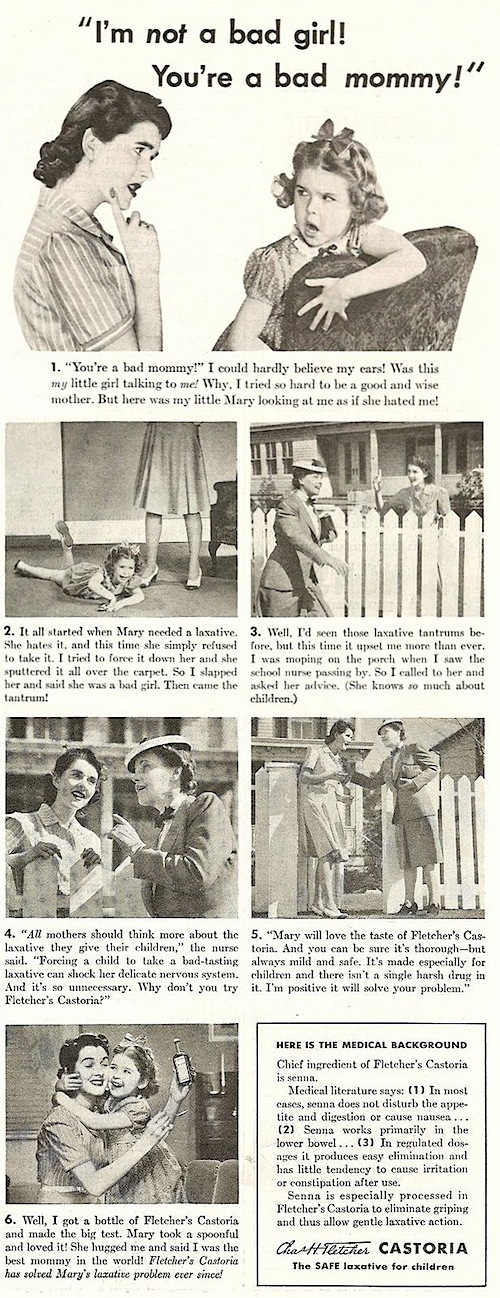August 7th, 2010 by Bryan Vartabedian, M.D. in Better Health Network, Health Tips, Humor
No Comments »

This “Fletchers Castoria” ad from 1941 is priceless. And as someone who spends his days working with bound-up grumps like Mary, I was reassured to know that horrific constipation is not a me-generation problem born of chicken fingers and Goldfish. ”Laxative tantrums,” however, are new to me. I seem to have pretty good luck with Miralax and Kristalose in my office. Your mileage (or tantrums) may vary.

*This blog post was originally published at 33 Charts*
August 7th, 2010 by KevinMD in Better Health Network, News, Opinion, Research
No Comments »

A recent study from the Annals of Internal Medicine found that doctors often discounted a patient’s social situation when making a medical diagnosis.
Lead researcher Saul Weiner “arranged to send actors playing patients into physicians’ offices and discovered that errors occurred in 78 percent of cases when socioeconomic concerns were a significant factor.”
Evan Falchuk, commenting on the results, provides some context:
It’s hard to expect even the most gifted clinician, trying to make it through yet another week of a hundred or more patient encounters, to get these difficult decisions right. Too much of the context of a patient’s care gets lost in the endless churn of patient visits that the health care system imposes on doctors.I suspect this is enormously frustrating for doctors, although it’s worse for patients. What the researchers call a failure to “individualize care,” a patient might call “not being paid attention to.” It’s a dynamic that anyone who’s been ill has probably seen firsthand.
These findings are entirely unsurprising. Read more »
*This blog post was originally published at KevinMD.com*
August 4th, 2010 by Bryan Vartabedian, M.D. in Better Health Network, Health Policy, News, Opinion
No Comments »

Recently I ran into the office manager for one of Houston’s largest pediatric practices. New patient visits are way down and their doctors are looking for ways to keep business rolling. The same day I picked up this piece in the Wall Street Journal which shows declining admissions and doctor visits as a national trend. This is bad news and shows how our faltering economy is finally working its way more visibly into healthcare.
And apparently we’re making fewer babies –- admissions to neonatal intensive care units are down. This is a problem. For large tertiary medical centers and hospitals specializing in maternal-child health, babies are the critical customers of a healthy operation.
A few thoughts on what to look for (or dare I say, what to “expect”) with fewer babies:
Pipelines. Look for tighter referral relationships between large tertiary centers and the smaller community hospitals that deliver babies in need of specialized care. Centers already aligned with ready-made networks should be well-positioned for the downturn. Read more »
*This blog post was originally published at 33 Charts*
August 4th, 2010 by BobDoherty in Better Health Network, Health Policy, News, Opinion, Research
No Comments »

When I was a much younger man I had a 1968 Chevy Impala. I loved its V-8 engine and spaciousness, but I paid a steep price for it. It consumed gas like a drunk on a binge. It was prone to breakdowns, usually in the left lane of a busy highway. Even as it consumed my limited financial resources, I couldn’t count on it to reliably get me to where I wanted to be. Yet I held onto it. One day, though, its transmission gave out, and I finally had to resign myself to buying a new, more reliable, more modern, and efficient vehicle. Yet to this day, I miss my clunker.
I am reminded of this when I think about the state of primary care today. Many of us are attached to a traditional primary care model that may no longer be economically viable — for physicians, for patients, and for purchasers.
We hold onto a model where primary care doctors are paid based on the volume of visits, not the quality and value of care rendered. We hold onto a model where patient records are maintained in paper charts in voluminous file folders, instead of digitalizing and connecting patient records. We hold onto a model that generates enormous overhead costs for struggling physician-owners but generates insufficient revenue. We hold onto a model that most young doctors won’t buy, as they pursue more financially viable specialties and practices. Read more »
*This blog post was originally published at The ACP Advocate Blog by Bob Doherty*
August 4th, 2010 by KevinMD in Better Health Network, Health Policy, News, Opinion, Research
No Comments »

Say the words, “Patient-centered medical home,” and you’re bound to get a variety of opinions.
On this blog alone, there are a variety of guest pieces critical of the effort, saying it does not increase patient satisfaction, nor does it save money. And that’s not good news for its advocates, who are pinning primary care’s last hopes on the model.
Medical homes hit the mainstream media recently, with Pauline Chen focusing one of her recent, weekly New York Times columns to the issue. She discussed the results of a demonstration project, showing some positive results. Read more »
*This blog post was originally published at KevinMD.com*














